What you see is what you get from Mr John Booth, former Southern Yorkshire butcher and half-serious racing driver: “I think my passion for the sport is pretty obvious,” he says. “I don’t hide much when I’m at the circuit.”
He does not. You walk past the (relatively small and efficient) Virgin Marussia motorhome at any given European Grand Prix and the chances are that Big John Booth will give you a quick wave if he happens to be in the vicinity. A wave. As in “Hey! How are you doing? Isn’t this fun?!” For a second out there you think you’re at a Formula Ford race at Snetteron, or Formula Three at Oulton. People aren’t supposed to smile genuinely in a Formula One paddock.
John Booth does. John Booth is still pinching himself. He’s Team Principal of an F1 team on the rise. After a bumpy first year, the key ingredients now appear to be in place. Behind them is the difficult business of shedding the team’s initial technical partner. John Booth the racing driver (with a string of early 1980s-Formula Ford wins behind him) morphed into John Booth of Manor Motorsport (joint kings of lower-rung British single-seater racing which begat such drivers as Kimi Raikkonen and Lewis Hamilton) which has now evolved into John Booth of Virgin Marussia F1.
“F1 is a whole new challenge,” he says in that slightly halting way of his. He isn’t the world’s greatest public speaker but there’s a charming, simple honesty in his demeanour that says, ‘This man’s a racer; and, yes, the car you buy from him will not let you down.’ In today’s F1 world of PR-this and sub-committee-that, John’s almost an anachronism, in other words – a man who’s made it to F1 via hard work and passion rather than through deft handling of politics or structured interviews.
“It’s not going racing the way it used to be,” he continues. “The business challenges of F1 take up most of my time – but I love it. I absolutely love it.”
Ah. The way it used to be…
John was a late starter. “I didn’t see a racing car until I was 24 and I started racing myself when I was 25. I left school at 15 and went straight into the family business. I was into flying. I started flying when I was young and I had ambitions to be a commercial pilot but in the end I went to work with the family in the food retail business. We dealt mainly with meat but in other produce too. We had about seven or eight shops in the South Yorkshire area.”
Then a friend persuaded him to attend the 1977 Kosset Six Hour race at Silverstone. Endurance sports cars comprised the main event. it was the Formula Fords, though, which captured John.
“Jim Walsh was winning everything at that time – he and some good Irish drivers were four abreast into Woodcote – and so that was it: I was hooked. I bought an Autosport, found a car for sale and went and bought it. It was a Hawke DL19. We didn’t have a clue what we were doing. We took the gearbox off and it took us four hours to change the ratios! Nor did I have any idea about driving. I’d driven a few sports cars on the road, and thought that I was quite quick, but of course on the circuit it was a completely different world. I was alongside guys who knew what they were doing and I soon realized that I knew nothing. Then it was a question of watching and learning, of teaching myself. John Village was always very helpful; he was an established Formula Ford driver from Sheffield and often helped us out with a bit of set-up equipment and few tips, but he didn’t give too much away, old John.”
John Booth soon became a regular winner. The family business paid for the racing and Formula Ford Van Diemens became his second home. “I won my first race at the end of 1980 in a Van Diemen RF80, and so started a long relationship with Ralf Firman. And we did well. I won lots of races, although I think I won most of them through guile and determination rather than skill and talent. I was always too heavy, of course…. It was when I stopped racing, and started to work with some real drivers, that I realized how far off I’d been! For me, driving was serious – but fun. I paid for my racing through hard work during the week there were no real ambitions. I never really thought further ahead than the next race.”
It was at the end of 1988 that John, like Frank Williams 20 years before him, began to think that he prefer to run his own team. “I looked into the garage and saw that there were no broken parts”: John’s way of saying that he had finally lost his aggression as a driver. “And so that was that. I had always stayed close to John Village, and he at that point was running some Formula Fords in Spain and in the UK. He was a bit busy with that so I began running his UK cars for him. I quickly realized that I enjoyed managing the cars much more than I did driving them.” John did a deal with Ralph Firman, to run the works Formula Renault Van Diemens in Duckhams colours in 1990.
Thus it began. You didn’t talk about Formula Renault in those years without also talking about Manor Motorsport. Formula Three, too. Paul Stewart Racing were the kings – but John Booth’s Manor team was always there, winning its share of races and titles.
John ran Kimi Raikkonen in Formula Renault, dominating the 2000 British Championship. “Back then, Formula Renault was the perfect grounding for slicks and wings. It basically took over from where F3 had been in the 1970s. It had a similar power-to-weight ratio. Kimi, who was a complete natural, got used to the car after about three or four tests. After that he just drove it to its maximum all season. I think he was a bit bored by it, to be honest. There was no challenge for him.”
John was looking forward to progressing to F3 with Kimi when he was asked by Kimi’s managers (Dave and Steve Robertson) to write a letter of reference for Peter Sauber. “Sauber was thinking of giving Kimi an F1 test. I was pretty sure that Herr Sauber had never even heard of John Booth, and that he would think I would know what I was talking about, but I went ahead and wrote the letter and the rest is history. Kimi progressed straight to F1 and never looked back.”
Co-incidences and chance meetings took John further down the road. “My business partner, David Matthews, runs a hotel in St Barts and Mansour Ojjeh, the part-owner of McLaren, went there on holiday. The two of them hit it off and so Mansour arranged for us to visit Martin Whitmarsh at McLaren, ostensibly to talk about buying the McLaren F3000 team; that didn’t go through but, when Lewis Hamilton was ready for cars, Martin gave us a call.
Lewis dominated the 2003 British Formula Renault Championship with Manor and at season’s end was quick at both Macau and Korea in John’s F3 car. Next stop: the 2004 F3 Euroseries with factory Mercedes engines.
“We soon realized, when we got to Europe, that it was a whole new level. We were absolutely nowhere for about 18 months. The Kumho tyre was quite a difficult tyre but, beyond that, the professionalism and the expertise of the teams there – teams like ASM and Prema – were a cut above us. It took us about 18 months, until about half-way through 2005, before we got the car onto the pace. That’s a long time to be struggling. Lewis was blinding fast, of course. Always was. He drives every lap as if it’s his last – and I think that’s very endearing. He’s just a pure, pure racer, isnt’ he?”
Today, despite his F1 commitments, John also runs a GP3 team, thus sustaining his link with grass roots. How does he see the current “feeder” system? Are there too many different championships? And where does F3 sit these days?
“My heart has always been with the British F3 Championship,” he says. “It would be easy to say, as some do, that there are now too many championships. But who has the right to say that Renault shouldn’t have a championship or that we shouldn’t have a GP3 championship? I think it’s up to those series to prove that they are the best platform for young drivers. At the moment, as I say, my heart is with F3, and I say that because the essence of the F3 regulations is almost identical to that of F1. There’s much more freedom in F3 and as a team or as an engineer you can contribute a tremendous amount to the outcome of the race. But GP3 is nonetheless The Standard, even if there’s not much you can do about it if you haven’t got yourself a top-line driver.
“Having said that, I do find it a great relief on a Sunday morning at European F1 races, when the guys are pushing our cars out onto the grid for the GP3 race. If you have a win it involves the whole F1 team – they get really hooked on the GP3.” The Marussia Virgin GP3 team, run by Pete Silwinski, finished third in the 2011 championship, with Indonesia’s Rio Haryanto winning in both Germany and Hungary and England’s Adrian Quaife-Hobbs in Valencia. (Adrian, who finished fifth in the series, will also drive the MVR-02 F1 car in the Abu Dhabi Young Driver test on November 14-15.)
Born of the stillborn “Buget-Cap” F1 scheme, John’s F1 project meanwhile survived choppy waters in 2010. Nick Wirth, who masterminded the car’s technology, massively improved reliability over the winter but the new car lacked performance from the first test in 2011. Eventually, after a difficult few weeks of meetings, the team announced a formal separation from Wirth Research.
“We had great hopes for this year’s car,” recalls John. “The second car, we were promised, would be much better than the 2010 car. And it terms of reliability it is much better. But it was also obvious from the first couple of runs that we were pretty much where we were last year – if not even worse, having lost ground to Team Lotus. We thought we understood the problems, thought we would have the correct step forward by Turkey. We spent a lot of money and effort getting the upgrades ready for Turkey and they were actually no improvement. And our investors want to see some progress. They’re not crazy. They don’t expect us to be on the podium next week but they want to see us going forward; but we weren’t going forward and so drastic steps had to be taken. It was difficult with Nick on a personal level but I don’t think you can have too many personal feelings in a business this size. These were quite difficult times for us; they were quite difficult negotiations to get through, but having Pat Symonds coming through as well was a fantastic boost for us. There’s not much that Pat doesn’t know about F1. I’ve known Pat for many years and I think his character stands up for itself. I have no issue with ‘Singapore-gate’, or ‘Crash-gate’, or whatever they call it. I’m not sure what really happened and I have no wish to know. I’ve got a lot of faith in Pat both as a person and as a Technical Director.”
The roots of growth – and thus of that mutual trust – are strong – the sort of roots that only real motor racing people would understand: John first met Pat through John Village, who used to go to school with Symonds back in Norfolk. “Pat was just progressing from Formula Ford when I was starting, so we’ve been acquaintances for a long time,” says John. Equally, it’s unlikely that neither Booth nor Symonds would have their new F1 technology link with McLaren if the right degree of trust had not developed in the F3 and – in Pat’s case – the Toleman-Benetton-Renault F1 days.
“I’d like to think that our F3 relationship gave Martin the confidence to go ahead with our new partnership,” says John. “It was pretty small fry, but nonetheless the business relationship was still important. We got to know each other pretty well and I like to think that it gave him confidence to go ahead with the deal.”
It’s an interesting deal, too, because VMF1 will continue to run Cosworth engines in 2012 – and therefore their own gearbox. To Force India, for example, McLaren supply a gearbox for the Mercedes engine. With Pat Symonds in the mix, though, you sense that the VMF1-McLaren relationship will break new ground in terms of access to CFD, vehicle dynamics and other details not normally associated with inter-team partnerships: “With McLaren we’re getting the whole package,” confirms John, “even down to purchasing, to the contact list of suppliers. And of course Martin and Paddy Lowe have known Pat for many years and respect him for what he’s achieved. At the moment it’s a bit strange because Pat isn’t allowed to attend races but he’s organizing the design team, leading the design philosophy and leading our partnership with McLaren. He’s in the office pretty much every day – and in the middle of it all we’re moving to Banbury, so that’ll be an hour and ten minutes for him from the South Cotswolds. For my part, my feelings about South Yorkshire are well-documented (!) but this is a once-in-a-lifetime chance and you have to take it.”
And so I think you can say that the prospects are bright for John Booth and his F1 team. Timo Glock, who is no fool, has eagerly re-signed for another year. John says he won’t announce his second driver until December, but I’d be surprised if it isn’t the brilliant Canadian, Robert Wickens. He dominated the WSR double-header at Silverstone in August and has been the VMF1 Reserve Driver since Canada. He is also backed by Marussia, the Russian company that now owns a major stake in VMF1.
“The biggest change for us last winter was Marussia taking a major stake in the company after being with us from Day One as sponsors,” says John. “That was quite a vote of confidence considering the year we’d had and it enabled us to keep most of the people with whom we started.
“We’ll be there. We’ll get there. Pat didn’t join us until May, and he really only got his hands on the reins in July, so we’re starting quite late. It’s a big ask to take a massive step forwards but, together with the McLaren connection, and the knowledge that’s available there, I’d be amazed if we didn’t take a fairly big step towards the mid-field in 2012.”
 Jules Bianchi, critically injured in the Japanese GP, has been flown back to the University Hospital in Nice. His family has released the following statement:
Jules Bianchi, critically injured in the Japanese GP, has been flown back to the University Hospital in Nice. His family has released the following statement:























